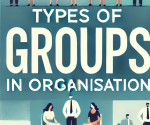Formal organization forms the backbone of any structured enterprise. It describes the hierarchy, roles, and responsibilities within an organization. A clear structure, defined roles, and documented rules that guide every member of his actions in an organization characterize features of a formal organization. In such a system, work would get done properly as it helps improve efficiency and effectiveness. Formed organizations use particular rules and regulations to realize group objectives.
What is a Formal Organisation?
A formal organization is a system that enables predetermined roles and responsibilities to govern the people within the organization. It operates on a structure that manifests accountability and control. The foremost aim of formal organizations is to achieve coordination of activities, maximize the usage of resources, and accomplish the stipulated objectives.
A formal organization is designed to create a standard operating system in which every individual knows his or her role. It decreases confusion and facilitates smooth workflow. Members of a formal organization work together for common goals, which are tied together by policies and procedures that govern their actions.
Key Elements of a Formal Organisation
A formal organization relies on key elements to ensure smooth functioning and goal achievement. These elements define the structure, communication, and responsibilities essential for organizational success.
- Defined Hierarchy: It involves positions like managers, team leaders, and executives to make sure that proper authority and responsibility flow.
- Specific Rules and Regulations: Formal organizations give rules to avoid confusion and to keep disciplined.
- Write communication: Most decisions and orders are written for account and transparency.
Hence, in one word, an organizational structure formalized emphasizes efficiency and coordinated working, which makes it necessary to reach goals in the long run.
Why is a Formal Organisational Structure Important?
Organizational structure, especially formal, is significant to the organization due to the systemic process towards achieving the objectives. Without an organizational structure, teams are bound for chaos and confusion and, therefore, inefficiency. The formal organizational structure importance lies in its capacity to facilitate streamlining and clarity.
- Role Clarity and Accountability: Every member of an organization has his or her position. This makes sure that there are no conflicts and overlaps. Members of the staff have defined functions with specific objectives. This leads to efficiency, but also, it also helps develop trust in the team.
- Systematizing Communication: Formal organizations make use of formal communication. Messages are channeled in ways that nothing will get lost and/or misinterpreted. Written orders leave evidence and are clear, an aspect that gives room for people to be accountable.
- Improving Decision Making: A formal organizational structure provides the leadership with a better platform for decision-making. Clear lines of reporting and definitions of roles assist managers in operating on a bigger scale and not managing the employees minute-by-minute basis.
- Resource Distribution:Resources are allocated based on roles and objectives. A structured approach avoids wastage and ensures that every department gets the tools it needs to succeed. This proper allocation of resources boosts overall performance.
- Maintaining Discipline: Policies and rules, therefore, facilitate discipline. Employees appreciate the consequences in case of their non-compliance, which implies adherence to organizational values.A formal organizational structure ensures business success through uniformity, stability, and permanence over time.
What Are the Features of Formal Organisation Structure?
The features of a formal organizational structure make it distinct and efficient. These features create order and provide a robust foundation for operations, ensuring systematic and smooth functioning.
Defined Hierarchy
A formal organization has its hierarchy defined. Employees know to whom they are reporting and their place in the structure. This brings about accountability and eliminates confusion.
- Top-Level Management: CEOs, directors, and other top executives that take part in strategic planning.
- Middle-Level Management: Head departments, organizes resources, and makes sure the team is working toward its goals.
- Operational-Level Employees: Do the day-to-day jobs under direction.
Hierarchy creates a systematic flow of responsibilities.
Written Rules and Policies
Organized organizations write down their rules. Workers follow these policies to ensure uniformity. Written policies also help in resolving disputes and in ensuring justice. Examples of Written Rules are:-
- Purpose
- Attendance Guidelines
- Maintain discipline
- Performance Metrics
- Assess employees
- Ethical Policies
- Transparency
Formal Communication
- Formal communication has a protocol. Employees communicate through reports, emails, and official meetings.
- This promotes clarity and rules out any form of miscommunication.Formal communication ensures structured and official exchanges of information.
- Employees communicate through reports, emails, and scheduled meetings. This approach minimizes misunderstandings and maintains transparency.
- The clear channels of communication allow efficient decision-making and accountability.
Specific Objectives
- In a formal organization, specific goals are set for each department and individual. It concerns the vision and mission of the company.
- A formal organization operates with clear and specific objectives. Each department and team has defined goals that align with the larger organizational mission.
- This focus on specific objectives ensures efforts are coordinated and results-driven, improving overall performance and productivity.
For example: the marketing team will reach out more to the customers. The sales will target revenue.
Standard Procedures
- In a formal organization, every job has a standard procedure. Employees undertake their work on the basis of the SOP.
- Characteristics of Formal Organisation Makes it Effective Reliable and Goal achieving. Standard procedures govern all activities within a formal organization.
- Tasks are carried out based on predefined guidelines and processes, ensuring uniformity and reducing errors.
- These procedures foster consistency, which is vital for maintaining quality and achieving organizational goals.
What is an Example of a Formal Organisational Structure?
Examples of formal organizational structures can be seen in all sectors. Such structures vary with the nature of the business and the purpose for which it operates. Let’s consider the characteristics of a typical formal organizational structure.
- Corporate Example: Multinational Companies (MNCs). The majority of the MNCs adopt a pyramidal structure. They differentiate the functions in various departments of HR, Finance, Marketing, and Operations.
- HR Department: It deals with the relations of employees and the management of payroll
- Finance Department: It manages budgeting and reports financial statements
- Marketing Team: It designs marketing campaigns to appeal to customers.
The formal structure of MNCs ensures everything goes on without any hassle all over the world. They have written policies and communication channels that prevent miscommunication.
- Educational Institution Example: Schools and colleges have a formal structure also.
- Principal/Director: The head of the institution.
- Teachers and Professors: Provide education according to the prescribed syllabus.
- Administrative Staff: Handle the daily work such as admission and maintenance.
In this manner, institutions retain discipline and gain their educational goal.
What is the Difference Between Formal and Informal Organisational Structures?
The formal and informal organizational structures are different. The formal ones are based on rules, while informal ones have an organic nature. Below are the detailed characteristics and differences between the two:
Characteristics of Formal Organisation
A formal organization operates on well-defined rules and roles. It provides structure and order, ensuring clarity in communication, responsibilities, and decision-making processes.
- Well-defined hierarchy: A structured chain of command ensures accountability.
- Roles and Responsibilities in Writing: Every member has documented duties.
- Official and Formalized Communication: Communication follows official channels to maintain professionalism.
Characteristics of Informal Organisation
An informal organization grows organically through relationships. It thrives on mutual trust and shared interests, promoting flexibility and fostering a sense of camaraderie among members.
- Based on Personal Relationships and Mutual Interests: Interactions arise naturally.
- No Fixed Hierarchy and No Rules: Relationships and roles evolve organically.
- Communication is Casual and Spontaneous: Conversations are informal and unstructured.
| Aspect | Formal Organisation | Informal Organisation |
| Rules and Policies | Clearly defined | Not documented |
| Communication | Structured | Unstructured |
| Purpose | Achieve organizational goals | Build interpersonal relations |
| Leadership | Assigned roles | Emerges naturally |
Advantages of Both Structures
Formal and informal structures complement each other in organizations. Combining their strengths fosters both efficiency and flexibility, creating a productive and harmonious work environment.
- Formal Organisation: Ensures discipline, clarity, and goal alignment.
- Informal Organisation: Encourages camaraderie, creativity, and flexible problem-solving.
A balanced approach combining both formal and informal structures makes organizations more vibrant and effective.
Features of Formal Organisation FAQs
What is the basic objective of a formal organization?
The formal organizations mainly aim at efficiently obtaining organizational goals. This structure provides an adequately defined framework in which workers perform according to some defined roles and responsibilities while adhering strictly to some defined rules.
Why do businesses need a formal organizational structure?
A formal organizational structure provides for clarity, accountability, and discipline. It helps business organizations streamline their operations, manage their resources, and improve their decision-making capacities.
How does communication work in a formal organization?
Communication in an organization takes the formal route. In reporting, information is passed on using the reports, emails, and actual meetings by officials.
Is it possible for informal structures to exist in an organization?
Yes, informal structures occur mainly because of the existing formal structures, as they are embedded within them. They promote interpersonal relationships and team integration.
What are the characteristics of a formal organizational structure?
Characteristics include a clear chain of command, formal rules, formal communication, clear goals, and standard operating procedures.


